Roofing Companies Milngavie
Find the best Roofing Services in Milngavie
Receive multiple Roofing Companies quotes for your project today! Compare profiles, reviews, accreditations, portfolio, etc... and choose the best offer.

C3 Scotland Limited
51 reviews12 Southview Road, Strathblane, G63 9JQ, GBWe are a roofing and cladding company, based in Glasgow and serving central Scotland.C3 Scotland Limited is a forward thinking and dynamic company that will cover all aspects of roofing and cladding works across Scotland. Employing only experienced roofers and cladders, we undertake a wide range of roofing projects from small roof repairs to large warehouses. At C3 Scotland Ltd in Glasgow, we pride ourselves on our precision and attention to detail with customer satisfaction on every project guaranteed. We encourage early client and contractor engagement to further maximise your journey, ensuring we provide the best value for your needs.Our extensive knowledge and experience in this sector helps us to understand and meet the requirements of our clients, providing a quality, hassle free service. Contact C3 Scotland Ltd in Glasgow for more details.
- Services
- Why Us?
- Our Team
- Testimonials
- Gallery
Get Quote
WTM services
52 reviewsGBWTM SERVICES is a leading and reputable Roofing and roughcasting Company serving Scotland. Since opening for business, we've taken a comprehensive approach to project management, providing our clients with a wide range of services to cover their needs. We cover all areas of Glasgow, Edinburgh, Dundee and Fife and surrounding areas. We offer expert advice on all things related to roofing, and our team of skilled and experienced roofers has been serving property owners in Glasgow, Edinburgh, Fife and Dundee and surrounding borders for over a decade. Our roofing and roughcasting specialists are knowledgeable and can offer solutions to a variety of roof-related problems, including new roof constructions, roof replacements, roof repairs, flashing repairs, guttering, fascia, and soffit board services and roughcasting. With the rising cost of energy, it is essential to undertake timely roof replacements and repairs to maintain your property's energy efficiency and save on energy bills. At WTM SERVICES, we understand this and offer free expert advice and competitive quotes from our friendly team. We take pride in providing exceptional roofing services while maintaining a price advantage over other roofing companies in Glasgow and beyond. Our 5-star reviews and referrals are a testament to our commitment to our customers. We are dedicated to offering speedy and high-quality solutions to all your roofing and roughcasting problems. As your committed "ROOFERS NEAR ME" service in Glasgow, we understand that roofing problems can be urgent, particularly during periods of adverse weather. Therefore, we aim to provide quick and reliable services.
- Services
- Why Us?
- Gallery
Get Quote
CP Roofing Solutions
543 reviewsThe Rectory, Floors St, Johnstone, PA5 8QS, GBAt CP Roofing Solutions, we pride ourselves on our knowledge and expertise. We are here to bring back respect to the roofing industry. A team of highly skilled tradesmen using only the best quality materials on the market, this is what makes us stand out from the rest. We undertake all aspects of roofing, from roof repairs to roof renewals. Before and after photos taken on all projects. Small enough to care & big enough to deliver. Relax you are in safe hands with CP Roofing Solutions!
- Services
- Why Us?
- Our Team
- Testimonials
- Gallery
Get Quote
Johnston
4.52 reviewsGBLanarkshire Roofing Network is a network of trusted roofing professionals serving Lanarkshire and surrounding areas. We offer a comprehensive range of roofing services for both domestic and commercial properties, including roof repairs, flat roofing, pitched roofing, fascias and soffits, and more. Our members are highly skilled and experienced in all aspects of roofing, ensuring quality workmanship and customer satisfaction. We understand the importance of a well-built roof, and we are committed to providing reliable and durable solutions to protect your property. Whether you need a small repair or a complete roof replacement, our team can help. Contact us today for a free quotation and let us take care of your roofing needs.
- Services
- Why Us?
- Accreditations
- Our Team
- Testimonials
- Gallery
Get Quote
Wren Roofing & Solar
59 reviewsGlasgow, GB- Services
- Why Us?
- Gallery
Get Quote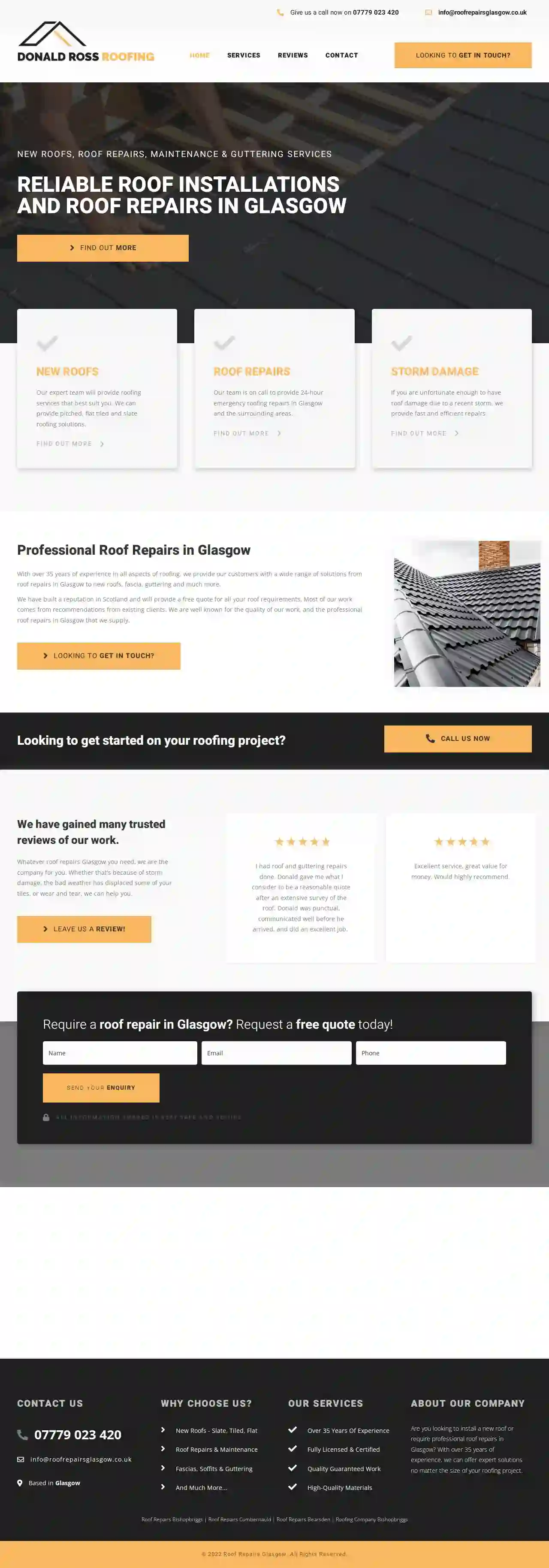
Donald Ross Roofing
Glasgow, GBAre you looking to install a new roof or require professional roof repairs in Glasgow? With over 35 years of experience, we can offer expert solutions no matter the size of your roofing project. We provide roofing services that best suit you. We can provide pitched, flat tiled and slate roofing solutions. Our team is on call to provide 24-hour emergency roofing repairs in Glasgow and the surrounding areas. If you are unfortunate enough to have roof damage due to a recent storm, we provide fast and efficient repairs. We have built a reputation in Scotland and will provide a free quote for all your roof requirements. Most of our work comes from recommendations from existing clients. We are well known for the quality of our work, and the professional roof repairs in Glasgow that we supply.
- Services
- Why Us?
- Testimonials
- Gallery
Get Quote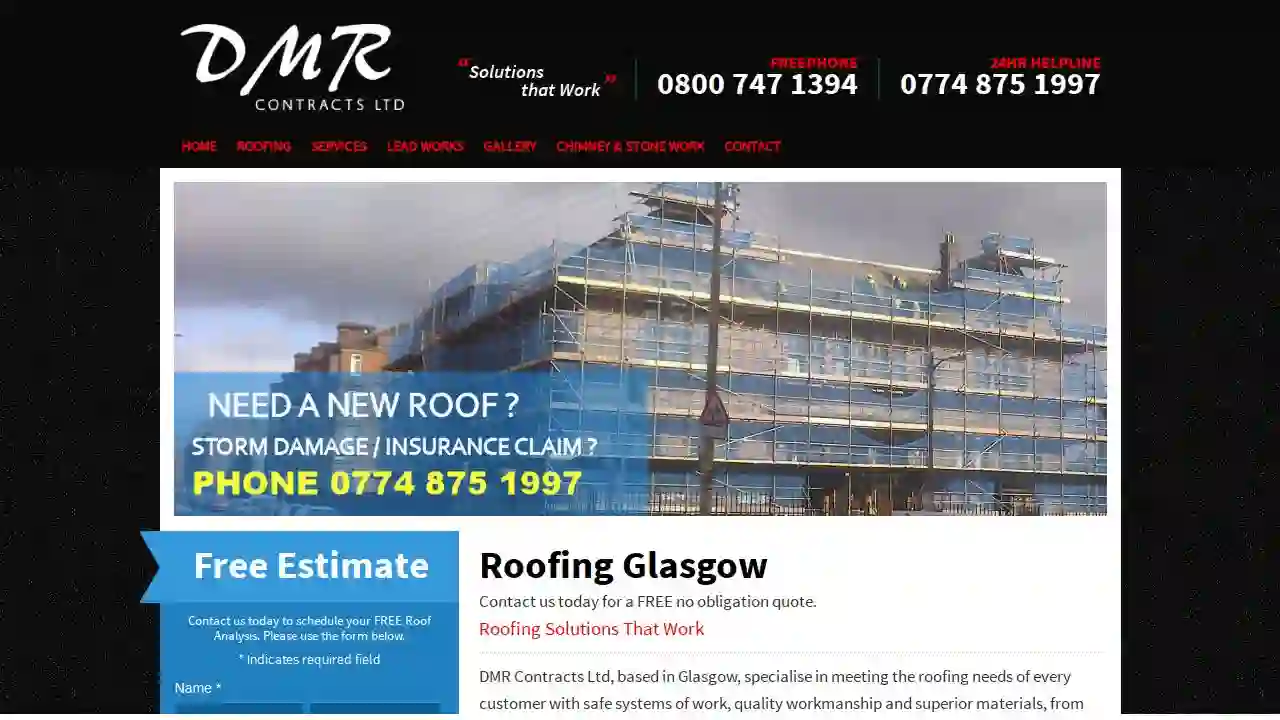
Glasgow's Finest Roofing Company
32 reviews100 Holloway Head, Birmingham, B1 1AA, GBDMR Contracts is a leading provider of commercial construction services in the UK. With over 20 years of experience, we have a proven track record of delivering high-quality projects on time and within budget. Our team of expert professionals is dedicated to providing our clients with the best possible service. We offer a wide range of services, including new build, refurbishment, fit-out, and maintenance. We are committed to using the latest technologies and techniques to ensure that our projects are completed to the highest standards. At DMR Contracts, we understand that every project is unique. That's why we take the time to get to know our clients and their needs. We work closely with them throughout the entire project lifecycle, from initial concept to final handover. Our goal is to exceed our clients' expectations and build long-lasting relationships. We are proud to have a strong reputation for quality, reliability, and customer satisfaction. Our commitment to excellence has earned us the trust of many leading businesses in the UK.
- Services
- Why Us?
Get Quote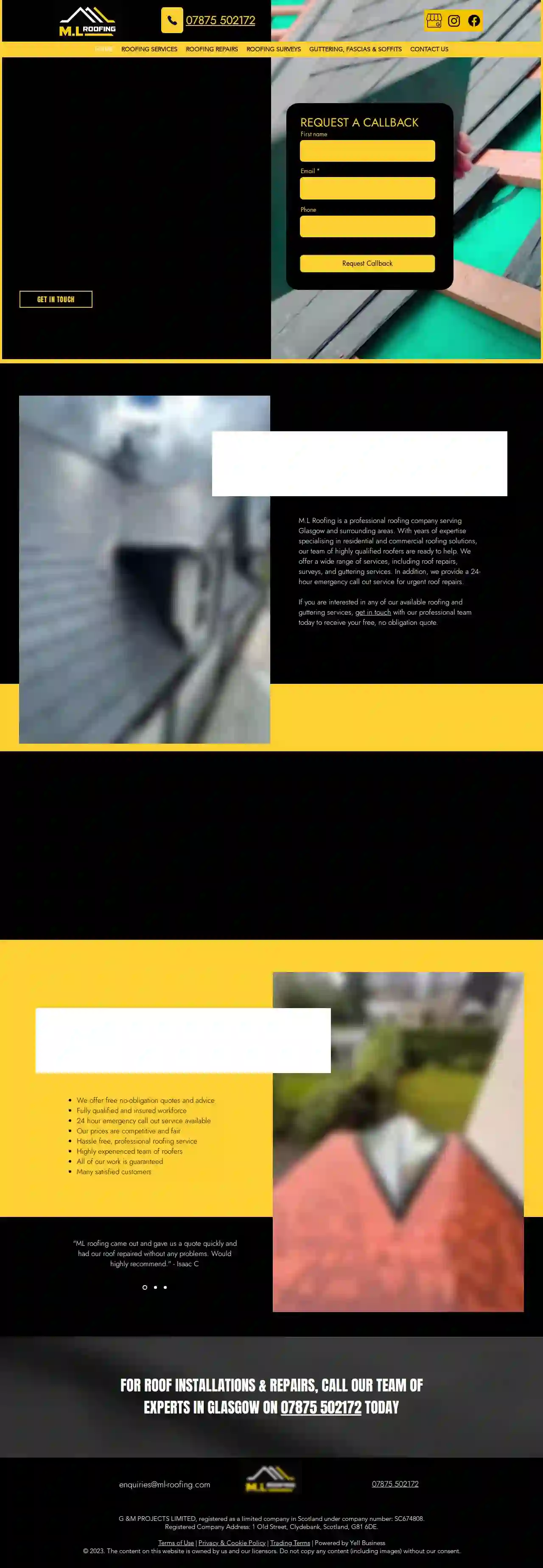
ML Roofing
4.878 reviews1 Old Street, Clydebank, GBM.L Roofing is a professional roofing company serving Glasgow and surrounding areas. With years of expertise specialising in residential and commercial roofing solutions, our team of highly qualified roofers are ready to help. We offer a wide range of services, including roof repairs, surveys, and guttering services. In addition, we provide a 24-hour emergency call out service for urgent roof repairs. We use only high quality materials and pride ourselves on carrying out all work to the highest of standards. If you are interested in any of our available roofing and guttering services, get in touch with our professional team today to receive your free, no obligation quote.
- Services
- Why Us?
- Testimonials
- Gallery
Get Quote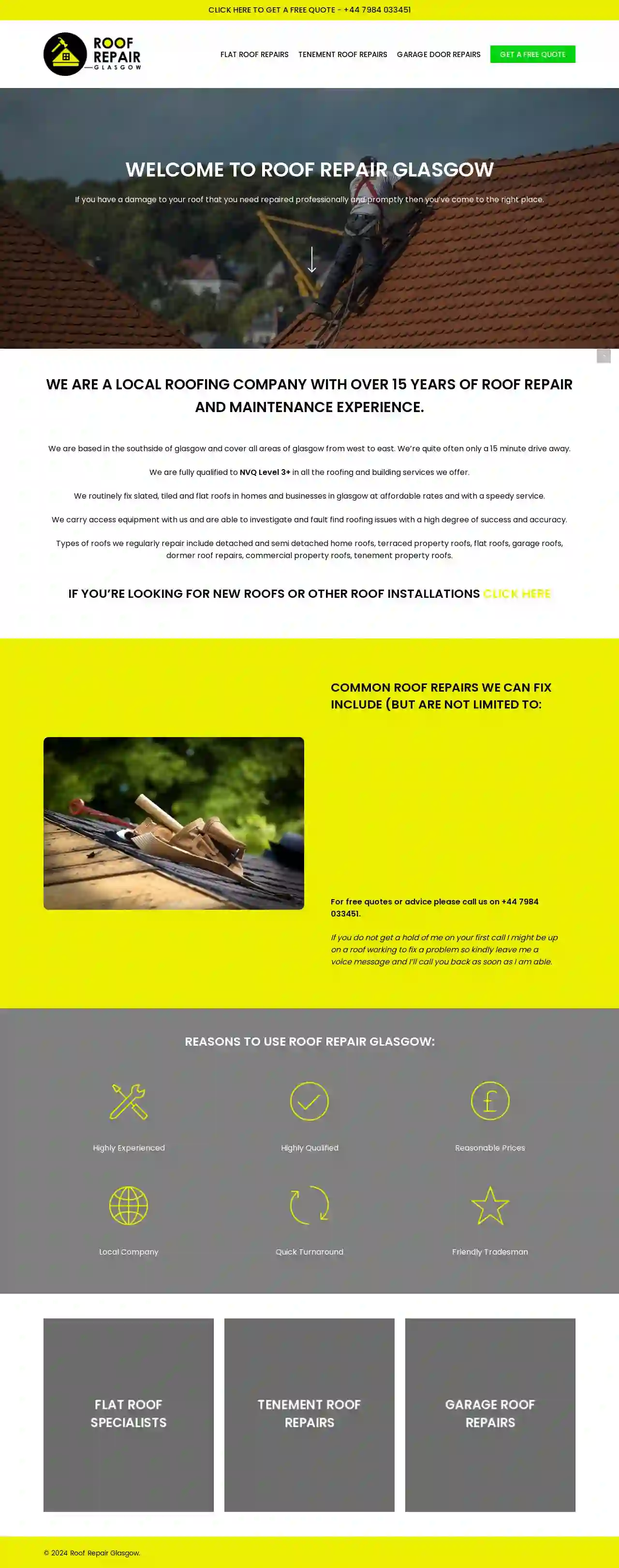
Roof Repair Glasgow
GBIf you have a damage to your roof that you need repaired professionally and promptly then you’ve come to the right place. We are a local roofing company with over 15 years of roof repair and maintenance experience. We are based in the southside of glasgow and cover all areas of glasgow from west to east. We’re quite often only a 15 minute drive away. We are fully qualified to NVQ Level 3+ in all the roofing and building services we offer. We routinely fix slated, tiled and flat roofs in homes and businesses in glasgow at affordable rates and with a speedy service. We carry access equipment with us and are able to investigate and fault find roofing issues with a high degree of success and accuracy. Types of roofs we regularly repair include detached and semi detached home roofs, terraced property roofs, flat roofs, garage roofs, dormer roof repairs, commercial property roofs, tenement property roofs. If you’re looking for new roofs or other roof installations click here Common roof repairs we can fix include (but are not limited to: Slipped or broken tiles or slates Water ingress via damaged sky/roof light Deteriorated mortar joints of roof ridges Deteriorated mortar joints of chimney stacks Loose or damaged flashing Water ingress or accumulation on a roof Damaged soffits or fascia. Damaged or blocked rainwater gutters. Damaged flat roofs. And much much more For free quotes or advice please call us on +44 7984 033451. If you do not get a hold of me on your first call I might be up on a roof working to fix a problem so kindly leave me a voice message and I’ll call you back as soon as I am able. Reasons to use roof repair glasgow: Highly Experienced Highly Qualified Reasonable Prices Local Company Quick Turnaround Friendly Tradesman Flat Roof Specialists Tenement Roof Repairs Garage Roof Repairs © 2024 Roof Repair Glasgow
- Services
- Why Us?
- Accreditations
- Gallery
Get Quote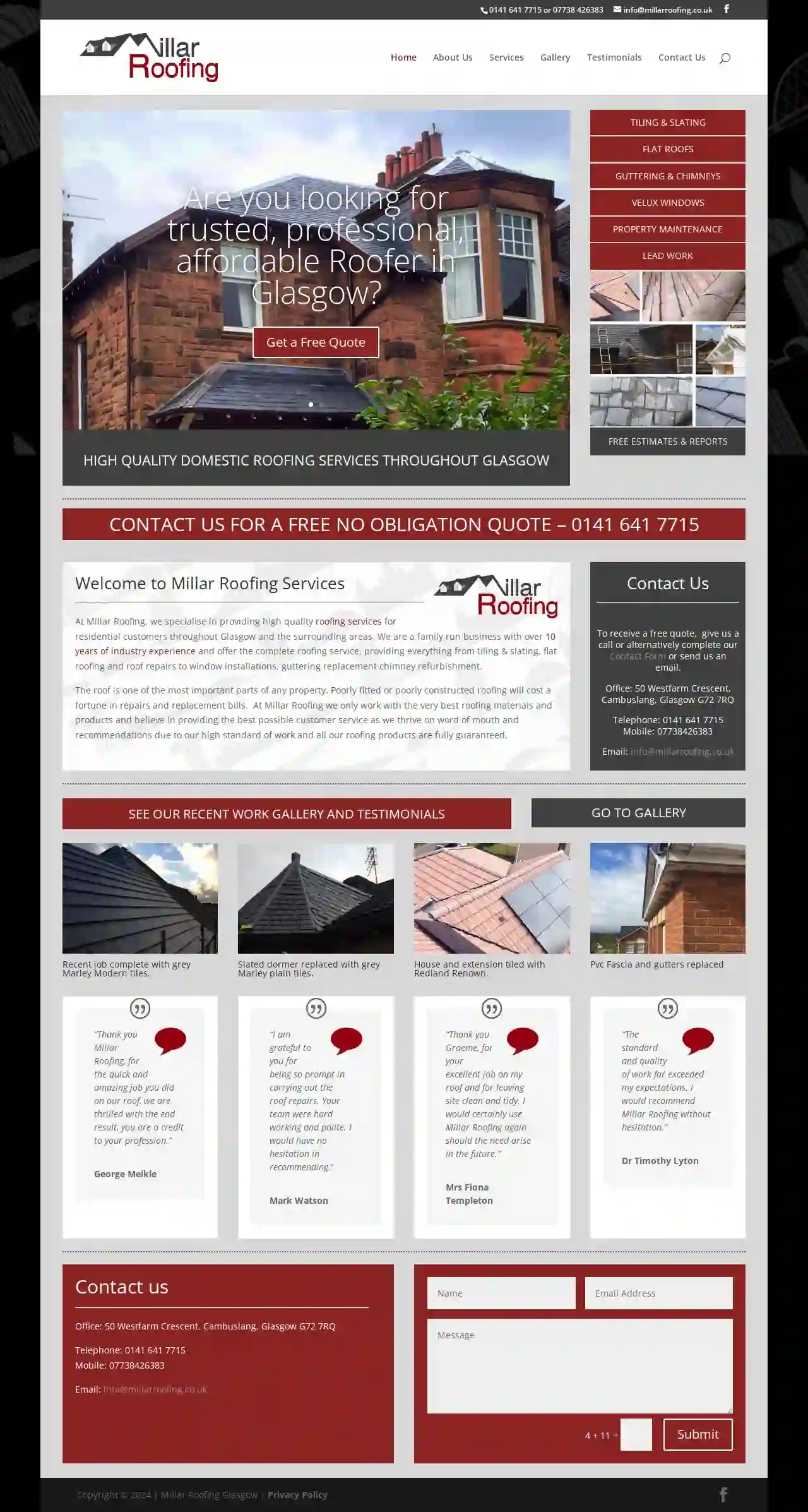
Millar Roofing
50 Westfarm Crescent, Cambuslang, G72 7RQ, GBAt Millar Roofing, we specialise in providing high quality roofing services for residential customers throughout Glasgow and the surrounding areas. We are a family run business with over 10 years of industry experience and offer the complete roofing service, providing everything from tiling & slating, flat roofing and roof repairs to window installations, guttering replacement chimney refurbishment. The roof is one of the most important parts of any property. Poorly fitted or poorly constructed roofing will cost a fortune in repairs and replacement bills. At Millar Roofing we only work with the very best roofing materials and products and believe in providing the best possible customer service as we thrive on word of mouth and recommendations due to our high standard of work and all our roofing products are fully guaranteed. Contact Us To receive a free quote, give us a call or alternatively complete our Contact Form or send us an email. Office: 50 Westfarm Crescent, Cambuslang, Glasgow G72 7RQ Telephone: 0141 641 7715 Mobile: 07738426383 Email: [email protected]
- Services
- Why Us?
- Our Team
- Testimonials
- Gallery
Get Quote
Over 12,314+ Roofing Businesses on our directory
Our roofing pros operate in Milngavie & surrounding areas!
Roofyng.co.uk has curated and vetted Top Roofing Businesses in and around Milngavie. Find the most trustworthy business today.
Frequently Asked Questions About Roofing Companies
- Asphalt Shingles: 20-30 years
- Metal Roofing: 40-70 years
- Tile Roofing: 50-100 years or more (clay and slate)
- Flat Roofing: 15-30 years (depending on material)
- Slate: 100 years or more
- Wood Shakes or Shingles: 30-50 years (with proper maintenance)
- Listed Buildings: Buildings with historical or architectural significance.
- Conservation Areas: Areas with special architectural or historical character.
- Changes to Roof Design: If you're making significant alterations to the roof's design, such as adding a dormer window or changing the pitch.
How long does a roof typically last?
What is fascia, and why is it important?
What is the difference between a roof overlay and a roof tear-off?
Roof Overlay: Installing a new layer of roofing material over the existing roof. It's less expensive and faster, but not always ideal.
Roof Tear-Off: Completely removing the existing roofing before installing a new one. More labor-intensive but allows for inspection and repairs to the roof deck.
A tear-off is typically preferred, but a roofing contractor can advise on the best approach for your situation.
Do I need planning permission to replace my roof in the UK?
How long does a roof typically last?
- Asphalt Shingles: 20-30 years
- Metal Roofing: 40-70 years
- Tile Roofing: 50-100 years or more (clay and slate)
- Flat Roofing: 15-30 years (depending on material)
- Slate: 100 years or more
- Wood Shakes or Shingles: 30-50 years (with proper maintenance)
What is fascia, and why is it important?
What is the difference between a roof overlay and a roof tear-off?
Roof Overlay: Installing a new layer of roofing material over the existing roof. It's less expensive and faster, but not always ideal.
Roof Tear-Off: Completely removing the existing roofing before installing a new one. More labor-intensive but allows for inspection and repairs to the roof deck.
A tear-off is typically preferred, but a roofing contractor can advise on the best approach for your situation.
Do I need planning permission to replace my roof in the UK?
- Listed Buildings: Buildings with historical or architectural significance.
- Conservation Areas: Areas with special architectural or historical character.
- Changes to Roof Design: If you're making significant alterations to the roof's design, such as adding a dormer window or changing the pitch.